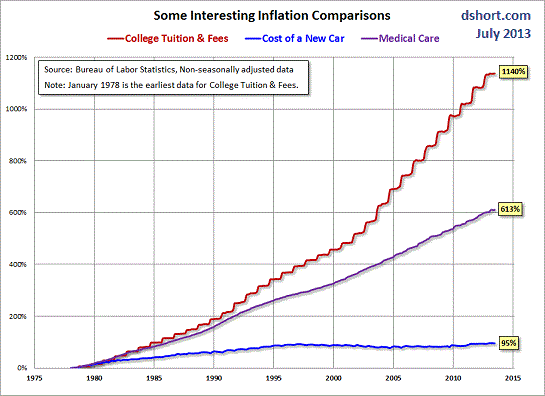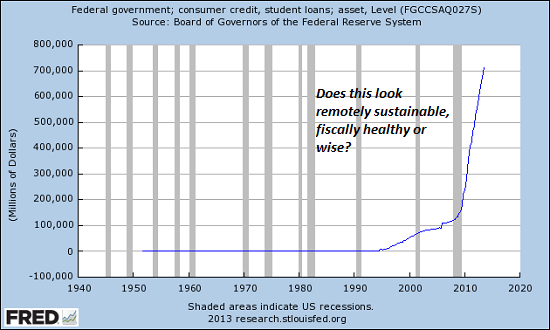Once we accredit the student, not
the institution, existing universities will compete directly with
Nearly Free Universities not in issuing diplomas but in how much
students actually learned and mastered.
One
of the key insights from recent work in psychology is that humans
tend to substitute easier problems rather than solve difficult
problems. Daniel
Kahneman explained this dynamic in his recent book Thinking,
Fast and Slow.
To “solve” a difficult problem we are
unfamiliar with, we substitute a lesser problem we already know the
answer to, and then declare we’ve “solved” the original (often
knotty, complex) problem.
The real problem then festers, unsolved and
addressed, while the misguided “solution” only drains resources
and exacerbates the real problem.
An excellent example of this dynamic is
higher education: the real problems are soaring costs and
sharply declining yields in actual learning and in the real-world
value of a diploma.
Consider
the study Academically
Adrift: Limited Learning on College Campuses which concluded
that “American
higher education is characterized by limited or no learning for a
large proportion of students.”
These charts illustrate the costs and
diminishing returns:

The yield (in earnings) on the increasingly
unaffordable college degree is declining sharply:
The Status Quo has substituted two false
“solutions” that completely ignore the real problems of soaring
costs and diminishing returns: increasing student loans and hiring
hundreds of thousands of non-teaching administrators.
While student loans have soared to over $1
trillion, with direct Federal loans ballooning from $115 billion to
over $700 billion in a few short years, only 37% of freshmen at
four-year colleges graduate in four years (58% finally graduate in
six years), and 53% of recent college graduates under the age of 25
are unemployed or doing work they could have done without going to
college.

In all, from 1987 until 2011-12–the most
recent academic year for which comparable figures are
available—universities and colleges collectively added 517,636
administrators and professional employees, according to the analysis
by the New England Center for Investigative Reporting.“There’s
just a mind-boggling amount of money per student that’s being spent
on administration,” said Andrew Gillen, a senior researcher at the
institutes. “It raises a question of priorities.”
The ratio of nonacademic employees to faculty
has also doubled. There are now two nonacademic employees at public
and two and a half at private universities and colleges for every one
full-time, tenure-track member of the faculty.
The number of employees in central system
offices has increased six-fold since 1987, and the number of
administrators in them by a factor of more than 34.
I
have demonstrated in my book The
Nearly Free University and The Emerging Economy: The Revolution in
Higher Education that the tuition for a four-year bachelor’s
degree could (and should) cost $5,000, not $100,000 or $200,000.
The technology and tools already exist
to accredit the student, not the institution and
provide distributed courses, adaptive learning and real-world,
workplace-based workshops for a tiny fraction of the ineffective,
unaffordable system of higher education we are currently burdened
with.
Once costs decline 95%, there is no need for
student loans or the bloated bureaucracies currently overseeing the
parasitic student-loan system.
Once we accredit the student, not the
institution, existing universities will compete directly with
Nearly Free Universities not in issuing diplomas but in how much
students actually learned and mastered. If students can learn as much
or more for $5,000 (including workshops in real-world workplaces)
than they do for $160,000 in conventional universities, then the
sectors of higher education that charge $160,000 for a 4-year degree
will vanish.
In essence, technology has leapfrogged the
existing higher education Status Quo, just as it has leapfrogged the
banking sector.
Gordon T. Long and I discuss these issues in
this 25-minute program:
Here is a taste of what we discuss:
THE LEGACY SYSTEM IS OBSOLETE
- Media and knowledge are no longer scarce—both are essentially free
- Students no longer need to be congregated in classrooms to hear oral lectures; the lectures can be distributed at almost no cost via the Internet
- The factory model of teaching the same texts and curriculum no longer makes sense; every digital device is a library and a display for oral lectures
- Lessons and methodologies of learning can now be tailored to individual students (adaptive learning) via interactive software
- The need for live oral lectures as the primary (and presumed to be best) mode of teaching has vanished
- Students learn mastery in workshops held in real-world workplaces, not classroomsTHE FUNDAMENTALS HAVE CHANGED
- Colleges must separate Research and Educational funding
- Education versus Occupational Training
- Internships versus Apprenticeships; why corporations are no longer training
- “Time is the New Competitive Dimension;” the educational systems needs to understand what this means
- The New Economy requires Soft Skills such as Collaboration, Lifetime Learning, Continual Innovation and the full spectrum of Entrepreneurial Skills
No comments:
Post a Comment